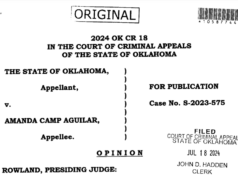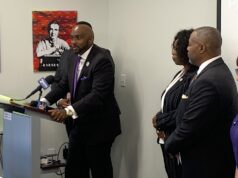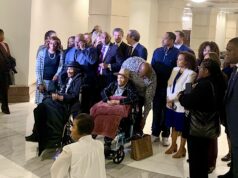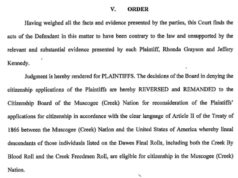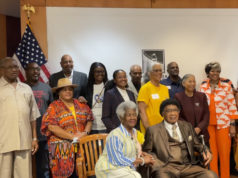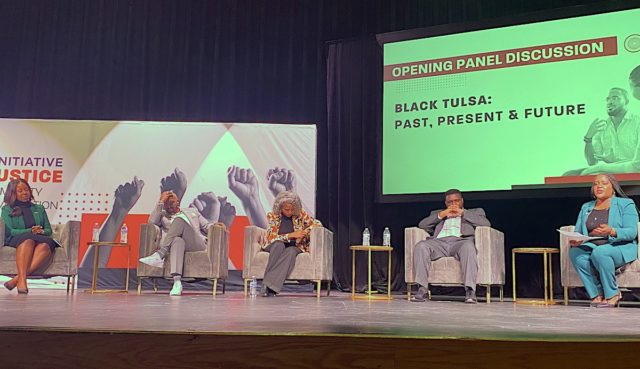

TULSA — Multiple panelists called for reparations to be paid to three living Tulsa Race Massacre survivors and their descendants and said the historic Greenwood District should be declared a national monument during an event hosted Saturday by the Congressional Black Caucus Foundation in Tulsa.
The event, called “Building Power in Black Tulsa: What It Means and How We Get There,” featured a panel conversation consisting of five Black political, business and nonprofit leaders in Tulsa. The dialogue focused on the past, present and future of Black Tulsans and included topics such as economic mobility, generational justice and liberation.
Legislators, policymakers, activists, and community members attended filed the Booker T. Washington High School auditorium in north Tulsa.
“Where else would we be other than in Tulsa? We’ve been in other cities across the nation such as Detroit, Michigan, and we’re very happy today to be here with you in Tulsa,” CBCF president and CEO Nicole Austin-Hillery said.
The Congressional Black Caucus Foundation is a Washington D.C.-based, nonpartisan, nonprofit policy and education foundation.
Participants included Oklahoma state Rep. Regina Goodwin (D-Tulsa), Tulsa City Councilor Vanessa Hall-Harper, Black Tech Street founder Tyrance Billingsley II, attorney and Justice of Greenwood founder and executive director Damario Solomon-Simmons, and Women Empowering Nations founder and executive director Carlisha Williams Bradley.
The panel was moderated by Terence Crutcher Foundation founder Tiffany Crutcher, whose twin brother was shot and killed by Tulsa Police Department officer Betty Shelby in 2016.
The heart of Black Oklahoma
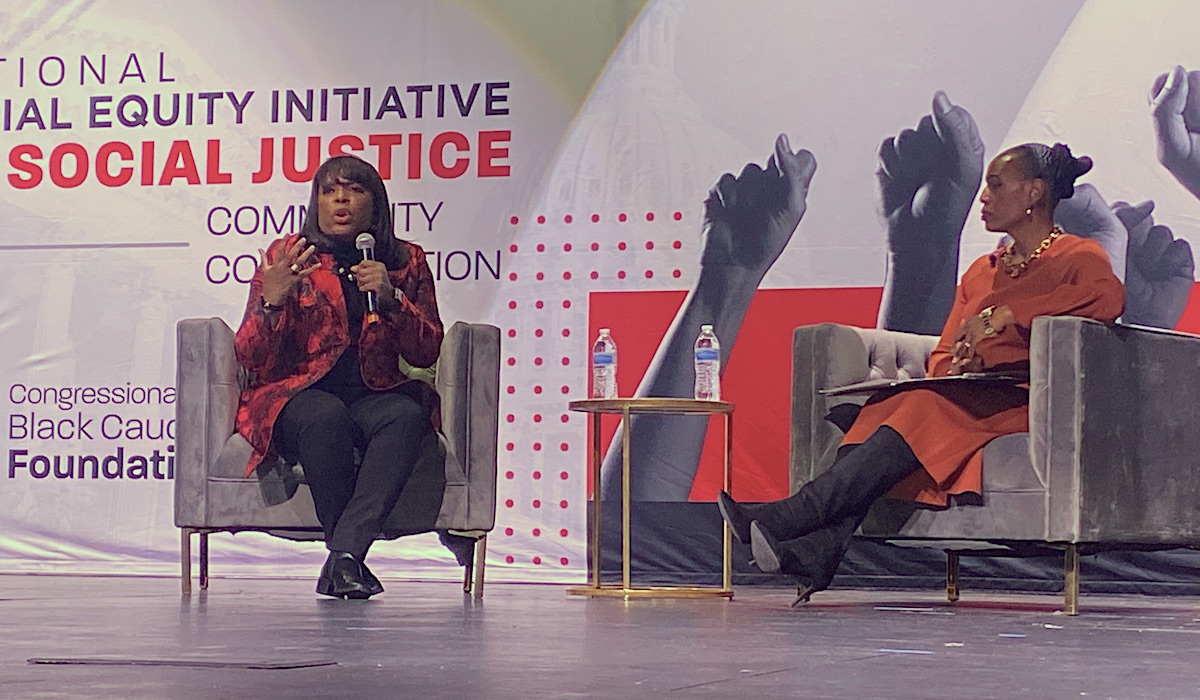
The Congressional Black Caucus Foundation event discussed the impact of the Tulsa Race Massacre, which occurred in the city’s Greenwood District in 1921. Over a century later, Tulsa remains significantly racially segregated, and Greenwood survivors’ and descendants’ pursuit of justice remains unresolved.
“All of us that live here in Tulsa, all of us that are descendants of those that are not, [we] have a very special history here,” Goodwin said. “We always say that our past is our present and [we’ve been] looking at the injustices in Tulsa for a century-plus. Our past is our present and the fight continues and [it’s] the very fight that our ancestors carried.”
Tulsa’s first economic boom occurred at the turn of the 20th century, when oil was discovered. Black Americans leaving former Confederate states migrated to Tulsa and established a freedom colony in the city’s Greenwood District. Greenwood was home to a vibrant, entrepreneurial, self-contained economy, and it became known as “Black Wall Street.”
“A century later, the history of Tulsa and the Tulsa Race Massacre has re-entered the public consciousness, drawing national attention to the Tulsa community and their fight for justice,” Crutcher said. “Our fight for justice.”
Hundreds were killed and 1,250 homes were burned down in the 1921 tragedy. The exact number of deaths is unknown. The massacre decimated the district’s Black middle class and what was considered to be the richest Black community in the U.S.
“I definitely feel that the impact of 1921 is alive and well, whether we want to acknowledge it, whether we can actualize it and put words to it or not,” Williams Bradley said. “It is definitely present.”
Recently, Williams Bradley was removed from the State Board of Education by Gov. Kevin Stitt. At the time, she was the only Black member and the only member other than new Superintendent of Public Instruction Ryan Walters to have public school teaching experience.
“We’re unconsciously [and] our kids are unconsciously carrying that piece of our history. And so, there’s so much work to be done,” Williams Bradley said.
Racial disparities exist in Tulsa with a significant divide existing between the city’s north and south sides. North Tulsa is generally described as the neighborhoods north of Interstate 244, which was built through the historic Greenwood area.
In 2019, north Tulsa was home to 41 percent of the city’s Black population, despite making up only 17 percent of Tulsa’s population, according to Human Rights Watch. The nonprofit reported the poverty rate of north Tulsa is more than double the citywide rate. Similarly, north Tulsa residents have higher rates of unemployment.
“We talked about generational wealth. There are some things called generational poverty and generational trauma, and that’s what we deal with here in Tulsa,” Solomon-Simmons said.
Solomon-Simmons is an attorney who has represented the remaining survivors of the Greenwood massacre.
Similarly, there are policing and health disparities between north and south Tulsa. Human Rights Watch found Black residents of Tulsa are 2.3 times more likely to be arrested than white residents. The Wall Street Journal, using 2018 data, reported that North Tulsans die up to 13 years earlier than South Tulsans.
The fight for Greenwood reparations
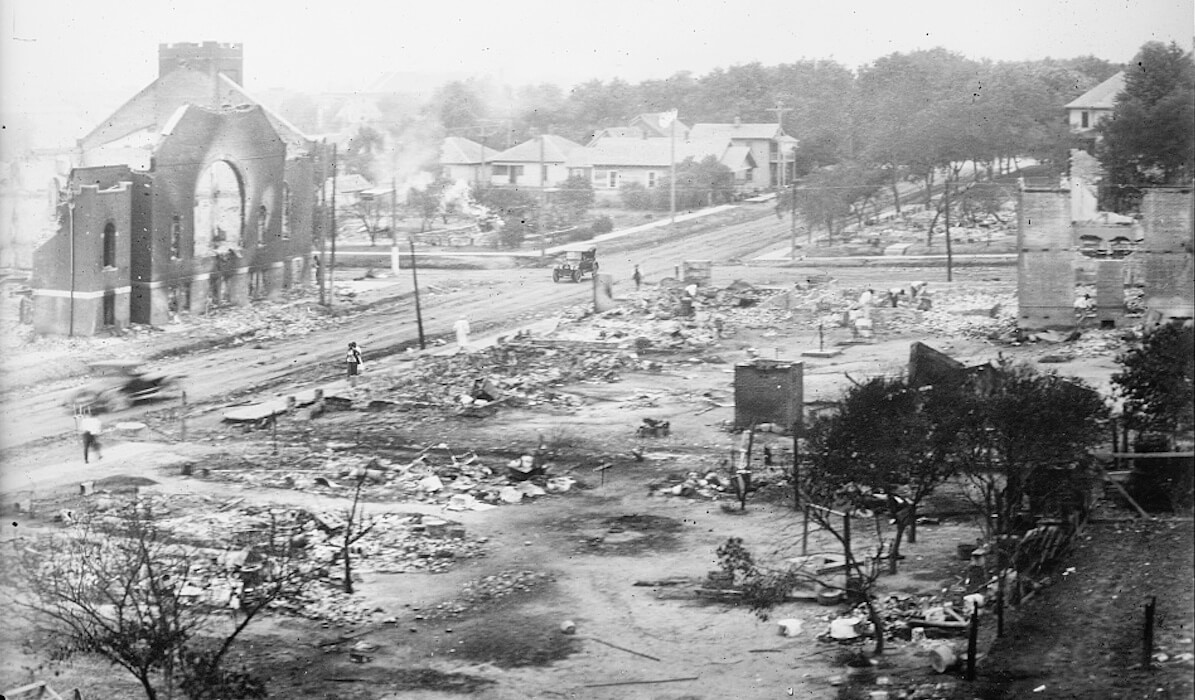
Multiple panelists called for reparations to be paid to the three living Greenwood survivors and the descendants of Greenwood residents, who never received compensation for the Tulsa Race Massacre’s loss of lives, homes and businesses.
“See, the massacre was not about some Black kid touching some white kid,” Solomon-Simmons said, referring to the elevator encounter between Dick Rowland and Sarah Page. “It was about taking the land that the Black people owned. That was just the ruse.”
Solomon-Simmons, who appeared in a 60 Minutes story about the Tulsa Race Massacre, called for reparations in the form of cash payments, mental health resources and an accounting for the land Greenwood residents lost. Others agreed.
“I see reparations as an issue that must be addressed at all levels of government,” said Hall-Harper, who has represented District 1 on the Tulsa City Council since 2016. “This country, at all levels, has destroyed, tried its best and has successfully disenfranchised the African in America from society. And so, what that looks like, I’m certainly not the expert.”
Between June 1921 and June 1922, former residents filed a lawsuit against the city seeking $1.8 million. Considered in January 2023 dollars, that number would be about $31 million, according to the Bureau of Labor Statistics’ CPI calculator. Tulsa residents affected by the 1921 event never received restitution from the city, courts nor insurance companies.
While Greenwood did rebuild after the massacre and continued to be home to Black residents, white urban planners largely destroyed the district between the 1960s to the 1980s through urban renewal policies. The policies included eminent domain, rezoning, bulldozing and building the highway through the area. Many residents left the community.
“They’ve done it with Japanese Americans,” Solomon-Simmons said, referencing reparations given to Japanese-Americans who were sent to internment camps during World War II.
The push to make Greenwood a national monument
In the backdrop of Saturday’s event, Oklahoma state Rep. Monroe Nichols (D-Tulsa) called on President Joe Biden to designate Greenwood a national monument.
“Greenwood’s legacy isn’t defined by the 1921 Massacre, but by the resiliency of Greenwood residents who built and rebuilt the community, which continues to thrive today,” Nichols said in a press release.
Crutcher said she and others plan to go to Washington to apply “positive pressure” to Oklahoma’s congressional delegation to designate the historic Greenwood District as a national monument.
“We just launched a huge campaign to get the president to build on his visit here two years ago, and to have him use his power to designate the historical Greenwood District as a national monument that will bring resources,” Crutcher said.
If Greenwood were to become a national monument, federal money and resources would flow into the community to preserve its history, Crutcher said.
The challenges faced by all-Black towns
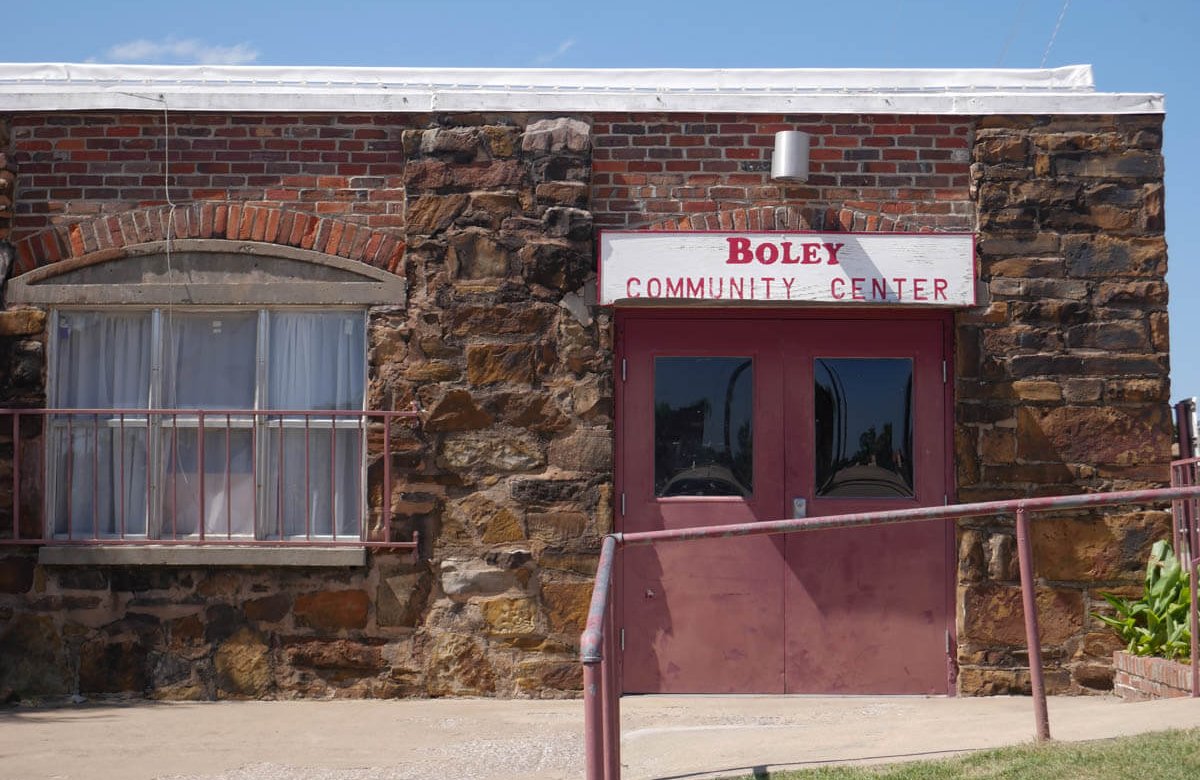
Panelists also discussed the decline of all-Black towns in Oklahoma, which once was home to around 50 communities founded by Black families. Now, only 13 remain.
“We understand that it’s done by people,” Hall-Harper said. “Unless people have the right to determine for themselves how they want to see their communities and are at the forefront of those changes, we will always be finding ourselves wondering what happened to the all-Black townships.
“And we need to understand there was segregation that led to those all-Black townships.”
After the Civil War and until 1920, many Black people settled in the Indian Territories and later Oklahoma for a variety of reasons, such as escaping discrimination and economic opportunity. The settlers of these towns largely consisted of people previously enslaved by the Five Tribes and later Black people leaving the Deep South.
“They weren’t wanting to hurt each other,” Hall-Harper said. “It was a collective and a cooperative economic system that was taking place.”
Historians have attributed multiple factors to the decline of Oklahoma’s all-Black towns, including economic hardships from the Great Depression and Dust Bowl. Many of these towns were in central and eastern Oklahoma with agriculture as their primary economic driver.
Solomon-Simmons said a lack of resources is continuing to cause the decline of the remaining historic communities, such as Boley, Langston Taft and Rentiesville.
“You see a lot of Native American communities around the state are actually kind of having a renaissance because they’re having so much resources being pumped into them by the nation and our federal government,” he said.
The attorney said Black Native American and Black communities do not have resources “owed” to them by the state and tribal nations. Solomon-Simmons noted that, during the COVID-19 pandemic, the Muscogee Creek Nation issued thousands of dollars to by-blood citizens — which excluded the Creek Freedmen.
“Our people continue to suffer,” Solomon-Simmons said. “That’s a great question, and we always have to keep in context that the massacre destroyed more than just the people here in Tulsa. It also gave institutions like the Creek Nation the ability to continue to destroy us because we’ve lost so much political and economic power.”
Prior to the panel discussion, Austin-Hillery interviewed CBCF board chairwoman U.S. Rep. Terri Sewell (D-AL7) about her efforts for Alabama’s Black community. Sewell also compared Tulsa to her hometown of Selma, both historic cities for Black Americans.
“By preserving this history, you acknowledge living history because walking among us are still people who experienced the racial violence that both Selma and Tulsa had and at the same time still have hope for an opportunity to get some restitution,” Sewell said. “Tulsa is very similar to Selma in the sense that you all are custodians of this history. Let’s make sure that we preserve it, and let’s make sure that people never ever forget.”









